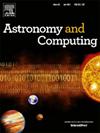Deep learning-based McIntosh classification of sunspot groups
IF 1.8
4区 物理与天体物理
Q2 ASTRONOMY & ASTROPHYSICS
引用次数: 0
Abstract
Different McIntosh classes of sunspot groups are associated with the occurrence of different levels flares. Thus, accurately classifying sunspot groups is of great significance for flare prediction. In this paper, a deep learning model named SungDC is proposed for the McIntosh classification of sunspot groups. The SungDC is designed as a single multi-classifier to simultaneously perform the classification of 60 McIntosh classes. An AGCM module is incorporated to enhance its feature extraction capability. An LCFPN neck is designed to mitigate the distortion of sunspot group features, thereby improving the quality of features. A deep learning dataset sourced from SDO/HMI continuous spectral full-disk solar images was built. In addition, a region-level data rotation augmentation technique (RLR) was improved to alleviate the problem of sample imbalance. The experimental results show that the AP, AR, and AF metrics of the SungDC are 0.645, 0.586, and 0.608, respectively. The precisions of the dki, eki, ehc, dkc, ekc, and fkc sunspot groups, which are tightly associated with M- and X-class flares, are 0.905, 0.828, 0.920, 0.710, 0.711, and 0.463, respectively. It demonstrates that the multi-classification challenge posed by sunspot groups can be feasibly addressed by deep learning methodologies. This method can also serve for research on flare prediction.
基于深度学习的太阳黑子群McIntosh分类
不同麦金托什类别的太阳黑子群与不同水平的耀斑的发生有关。因此,准确分类太阳黑子群对耀斑预测具有重要意义。本文提出了一种用于太阳黑子群McIntosh分类的深度学习模型SungDC。SungDC被设计成一个单一的多分类器,同时执行60个麦金托什类的分类。集成了AGCM模块,增强了特征提取能力。为了减轻太阳黑子群特征失真,提高特征质量,设计了LCFPN颈。建立了基于SDO/HMI连续光谱全盘太阳图像的深度学习数据集。此外,改进了区域级数据旋转增强技术(RLR),以缓解样本不平衡问题。实验结果表明,SungDC的AP、AR和AF指标分别为0.645、0.586和0.608。与M级和x级耀斑密切相关的太阳黑子群dki、eki、ehc、dkc、ekc和fkc的精度分别为0.905、0.828、0.920、0.710、0.711和0.463。这表明,太阳黑子群带来的多分类挑战可以通过深度学习方法解决。该方法也可用于耀斑预测的研究。
本文章由计算机程序翻译,如有差异,请以英文原文为准。
求助全文
约1分钟内获得全文
求助全文
来源期刊

Astronomy and Computing
ASTRONOMY & ASTROPHYSICSCOMPUTER SCIENCE,-COMPUTER SCIENCE, INTERDISCIPLINARY APPLICATIONS
CiteScore
4.10
自引率
8.00%
发文量
67
期刊介绍:
Astronomy and Computing is a peer-reviewed journal that focuses on the broad area between astronomy, computer science and information technology. The journal aims to publish the work of scientists and (software) engineers in all aspects of astronomical computing, including the collection, analysis, reduction, visualisation, preservation and dissemination of data, and the development of astronomical software and simulations. The journal covers applications for academic computer science techniques to astronomy, as well as novel applications of information technologies within astronomy.
 求助内容:
求助内容: 应助结果提醒方式:
应助结果提醒方式:


